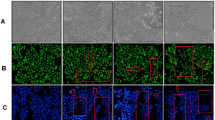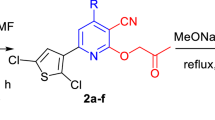Abstract
Abstract
Herein, we describe the synthesis of twenty-one novel water-soluble monocationic 2-aryl/heteroaryl-substituted 6-(2-imidazolinyl)benzothiazole mesylates 3a–3u and present the results of their anti-proliferative assays. Efficient syntheses were achieved by three complementary simple two-step synthetic protocols based on the condensation reaction of aryl/heteroaryl carbaldehydes or carboxylic acid. We developed an eco-friendly synthetic protocol using glycerol as green solvent, particularly appropriate for the condensation of thermally and acid-sensitive heterocycles such as furan, benzofuran, pyrrole, and indole. Screening of anti-proliferative activity was performed on four human tumour cell lines in vitro including pancreatic cancer (CFPAC-1), metastatic colon cancer (SW620), hepatocellular carcinoma (HepG2), and cervical cancer (HeLa), as well as in normal human fibroblast cell lines. All tested compounds showed strong to moderate anti-proliferative activity on tested cell lines depending on the structure containing aryl/heteroaryl moiety coupled to 6-(2-imidazolinyl)benzothiazole moiety. The most potent cytostatic effects on all tested cell lines with \(\hbox {IC}_{50}\) values ranging from 0.1 to 3.70 \(\upmu \hbox {M}\) were observed for benzothiazoles substituted with naphthalene-2-yl 3c, benzofuran-2-yl 3e, indole-3-yl 3j, indole-2-yl 3k, quinoline-2-yl 3s, and quinoline-3-yl 3t and derivatives substituted with phenyl 3a, naphthalene-1-yl 3b, benzothiazole-2-yl 3g, benzothiazole-6-yl 3h, N-methylindole-3-yl 3l, benzimidazole-2-yl 3n, benzimidazole-5(6)-yl 3o, and quinolone-4-yl 3u with \(\hbox {IC}_{50}\) values ranging from 1.1 to 29.1 \(\upmu \hbox {M}\). Based on obtained anti-proliferative activities, 3D-QSAR models for five cell lines were derived. Molecular volume, molecular surface, the sum of hydrophobic surface areas, molecular mass, and possibility of making dispersion forces were identified by QSAR analyses as molecular properties that are positively correlated with anti-proliferative activity, while compound’s capability to accept H-bond was identified as a negatively correlated property. Comparison of molecular properties identified for different cell lines enabled assumptions about similarity of mode of action through which anti-proliferative activities against different cell lines are accomplished. Novel compounds that are predicted to have enhanced activities in comparison with herein presented ones were designed using 3D-QSAR analysis as guideline.
Graphical abstract








Similar content being viewed by others
References
Akhtar J, Khan AA, Ali Z, Haider R, Yar MS (2017) Structure–activity relationship (SAR) study and design strategies of nitrogen-containing heterocyclic moieties for their anticancer activities. Eur J Med Chem 125:143–189. https://doi.org/10.1016/j.ejmech.2016.09.023
Keri RS, Patil MR, Patil SA, Budagumpi S (2015) A comprehensive review in current developments of benzothiazole-based molecules in medicinal chemistry. Eur J Med Chem 89:207–251. https://doi.org/10.1016/j.ejmech.2014.10.059
Kamal A, Syed MAH, Mohammed SM (2015) Therapeutic potential of benzothiazoles: a patent review (2010–2014). Expert Opin Ther Pat 25:335–349. https://doi.org/10.1517/13543776.2014.999764
Ahmed K, Venkata SYV, Mohammed NAK, Sultana F, Methuku KR (2012) Recent advances on structural modifications of benzothiazoles and their conjugate systems as potential chemotherapeutics. Expert Opin Invest Drugs 21:619–635. https://doi.org/10.1517/13543784.2012.676043
Weekes AA, Westwell AD (2009) 2-Arylbenzothiazole as a privileged scaffold in drug discovery. Curr Med Chem 16:2430–2440. https://doi.org/10.2174/092986709788682137
Shi D, Bradshaw TD, Wrigley S, McCall CJ, Lelieveld P, Fichtner Stevens MFG (1996) Antitumor benzothiazoles. 3. Synthesis of 2-(4-aminophenyl)benzothiazoles and evaluation of their activities against breast cancer cell lines in vitro and in vivo. J Med Chem 39:3375–3384. https://doi.org/10.1021/jm9600959
Mortimer CG, Wells G, Crochard J-P, Stone EL, Bradshaw TD, Stevens MFG, Westwell AD (2006) Antitumor benzothiazoles. 26. 2-(3,4-dimethoxyphenyl)-5-fluorobenzothiazole (GW 610, NSC 721648), a simple fluorinated 2-arylbenzothiazole, shows potent and Selective inhibitory activity against lung, colon, and breast cancer cell lines. J Med Chem 49:179–185. https://doi.org/10.1021/jm050942k
Stone EL, Citossi F, Singh R, Kaur B, Gaskell M, Farmer PB, Monks A, Hose C, Stevens MFG, Leong C-O, Stocks M, Kellam B, Marlow M, Bradshaw TD (2015) Antitumour benzothiazoles. Part 32: DNA adducts and double strand breaks correlate with activity; synthesis of 5F203 hydrogels for local delivery. Bioorg Med Chem 23:6891–6899. https://doi.org/10.1016/j.bmc.2015.09.052
Ashraf M, Shaik TB, Malik MS, Syed R, Mallipeddi PL, Vardhan MVPSV, Kamal A (2016) Design and synthesis of cis-restricted benzimidazole and benzothiazole mimics of combretastatin A-4 as antimitotic agents with apoptosis inducing ability. Bioorg Med Chem Lett 26:4527–4535. https://doi.org/10.1016/j.bmcl.2016.06.044
Torres FC, García-Rubiño ME, Lozano-López C, Kawano DF, Eifler-Lima VL, von Poser GL, Campos JM (2015) Imidazoles and benzimidazoles as tubulin-modulators for anti-cancer therapy. Curr Med Chem 22:1312–1323. https://doi.org/10.2174/0929867322666150114164032
Racané L, Tralić-Kulenović V, Kraljević Pavelić S, Ratkaj I, Peixoto P, Nhili R, Depauw S, Hildebrand MP, David-Cordonnier MH, Pavelić K, Karminski-Zamola G (2010) Novel diamidino-substituted derivatives of phenylbenzothiazolyl-and dibenzothiazolyl-furans and thiophenes: synthesis, antiproliferative and DNA binding properties. J Med Chem 53:2418–2432. https://doi.org/10.1021/jm901441b
Racané L, Kraljević Pavelić S, Ratkaj I, Stepanić V, Pavelić K, Tralić-Kulenović V, Karminski-Zamola G (2012) Synthesis and antiproliferative evaluation of some new amidino-substituted bis-benzothiazolyl-pyridines and pyrimidine. Eur J Med Chem 55:108–116. https://doi.org/10.1016/j.ejmech.2012.07.005
Racané L, Kraljević Pavelić S, Nhili R, Depauw S, Paul-Constant C, Ratkaj I, David-Cordonnier M-H, Pavelić K, Tralić-Kulenović V, Karminski-Zamola G (2013) New anticancer active and selective phenylene-bisbenzothiazoles: synthesis, antiproliferative evaluation and DNA binding. Eur J Med Chem 63:882–891. https://doi.org/10.1016/j.ejmech.2013.02.026
Racané L, Stojković R, Tralić-Kulenović V, Cerić H, Đaković M, Ester K, Mišir Krpan A, Radić Stojković M (2014) Interactions with polynucleotides and antitumor activity of amidino and imidazolinyl substituted 2-phenylbenzothiazole mesylates. Eur J Med Chem 86:406–419. https://doi.org/10.1016/j.ejmech.2014.08.072
Racané L, Sedić M, Ilić N, Aleksić M, Kraljević Pavelić S, Karminski-Zamola G (2017) Novel 2-thienyl- and 2-benzothienyl-substituted 6-(2-imidazolinyl)benzothiazoles: synthesis; in vitro evaluation of antitumor effects and assessment of mitochondrial toxicity. Anti-Cancer Agents Med Chem 17:57–66. https://doi.org/10.2174/1871520615666160504094753
Cruciani G, Crivori P, Carrupt P-A, Testa B (2000) Molecular fields in quantitative structure–permeation relationships: the VolSurf approach. J Mol Struct Theochem 503:17–30. https://doi.org/10.1016/S0166-1280(99)00360-7
Cruciani G, Pastor M, Guba W (2000) VolSurf: a new tool for pharmacokinetic optimization of lead compounds. Eur J Pharm Sci 11:S29–S39. https://doi.org/10.1016/S0928-0987(00)00162-7
Bertoša B, Aleksić M, Karminiski-Zamola G, Tomić S (2010) QSAR analysis of antitumor active amides and quinolones from thiophene series. Int J Pharm 394:106–114. https://doi.org/10.1016/j.ijpharm.2010.05.014
Čaleta I, Kralj M, Marjanović M, Bertoša B, Tomić S, Pavlović G, Pavelić K, Karminski-Zamola G (2009) Novel cyano- and amidinobenzothiazole derivatives: synthesis, antitumor evaluation, and X-ray and quantitative structure–activity relationship (QSAR) analysis. J Med Chem 52:1744–1756. https://doi.org/10.1021/jm801566q
Vujasinović I, Paravić-Radičević A, Mlinarić-Majerski K, Brajša K, Bertoša B (2012) Synthesis and biological validation of novel pyrazole derivatives with anticancer activity guided by 3D-QSAR analysis. Bioorg Med Chem 20:2101–2110. https://doi.org/10.1016/j.bmc.2012.01.032
Aleksić M, Bertoša B, Nhili R, Depauw S, Martin-Kleiner I, David-Cordonnier M-H, Tomić S, Kralj M, Karminski-Zamola G (2014) Anilides and quinolones with nitrogen-bearing substituents from benzothiophene and thienothiophene series: synthesis, photochemical synthesis, cytostatic evaluation, 3D-derived QSAR analysis and DNA-binding properties. Eur J Med Chem 71:267–281. https://doi.org/10.1016/j.ejmech.2013.11.010
Aleksić M, Bertoša B, Nhili R, Uzelac L, Jarak I, Depauw S, David-Cordonnier M-H, Kralj M, Tomić S, Karminski-Zamola G (2012) Novel substituted benzothiophene and thienothiophene carboxanilides and quinolones: synthesis, photochemical synthesis, DNA-binding properties, antitumor evaluation and 3D-derived QSAR analysis. J Med Chem 55:5044–5060. https://doi.org/10.1021/jm300505h
Fortuna G, Barresi V, Berellini G, Musumarra G (2008) Design and synthesis of trans 2-(furan-2-yl)vinyl heteroaromatic iodides with antitumor activity. Bioorg Med Chem 16:4150–4159. https://doi.org/10.1016/j.bmc.2007.12.042
Racanè L, Tralić-Kulenović V, Mihalić Z, Pavlović G, Karminski-Zamola G (2008) Synthesis of new amidino-substituted 2-aminothiophenoles: mild basic ring opening of benzothiazole. Tetrahedron 64:11594–11602. https://doi.org/10.1016/j.tet.2008.10.026
Bistrzycki A, Przeworski G (1912) Die Konstitution der Verbindungen aus o-Diaminen und \(\alpha \)-Oxysäuren. Acetylierung von Benzimidazolen. Ber Dtsch Chem Ges 45:3483–3495. https://doi.org/10.1002/cber.191204503105
Prajapati NP, Vekariya RH, Borad MA, Patel HD (2014) Recent advances in the synthesis of 2-substituted benzothiazoles: a review. RSC Adv 4:60176–208. https://doi.org/10.1039/C4RA07437H
Mene D, Kale M (2016) Exploration of different methodologies for synthesizing biologically important benzothiazoles: an overview. Curr Org Synth 13:41–57. https://doi.org/10.2174/1570179412999150723154128
Gu Y, Jérôme F (2013) Bio-based solvents: an emerging generation of fluids for the design of eco-efficient processes in catalysis and organic chemistry. Chem Soc Rev 42:9550–9570. https://doi.org/10.1039/c3cs60241a
Bachhav HM, Bhagat SB, Telvekar VN (2011) Efficient protocol for the synthesis of quinoxaline, benzoxazole and benzimidazole derivatives using glycerol as green solvent. Tetrahedron Lett 52:5697–5701. https://doi.org/10.1016/j.tetlet.2011.08.105
Sadek KU, Mekheimer RA, Hameed AMA, Elnahas F, Elnagdi MH (2012) Green and highly efficient synthesis of 2-arylbenzothiazoles using glycerol without catalyst at ambient temperature. Molecules 17:6011–6019. https://doi.org/10.3390/molecules17056011
Gazivoda T, Raić-Malić S, Krištafor V, Makuc D, Plavec J, Bratulic S, Kraljević Pavelić S, Pavelić K, Naesens L, Andrei G, Snoeck R, Balzarini J, Mintas M (2008) Synthesis, cytostatic and anti-HIV evaluations of the new unsaturated acyclic C-5 pyrimidine nucleoside analogues. Bioorg Med Chem 16:5624–5634. https://doi.org/10.1016/j.bmc.2008.03.074
Acknowledgements
This work has been supported by Croatian Science Foundation under the Project HRRZ-IP-2013-11-5596 (Synthesis and cytostatic evaluations of novel nitrogen heterocycles library). We greatly acknowledge the support of University of Rijeka research Grant 13.11.1.1.11 and the project “Research Infrastructure for Campus-based Laboratories at University of Rijeka”, co-financed by European Regional Development Fund (ERDF).
Author information
Authors and Affiliations
Corresponding authors
Electronic supplementary material
Below is the link to the electronic supplementary material.
Rights and permissions
About this article
Cite this article
Racané, L., Ptiček, L., Sedić, M. et al. Eco-friendly synthesis, in vitro anti-proliferative evaluation, and 3D-QSAR analysis of a novel series of monocationic 2-aryl/heteroaryl-substituted 6-(2-imidazolinyl)benzothiazole mesylates. Mol Divers 22, 723–741 (2018). https://doi.org/10.1007/s11030-018-9827-2
Received:
Accepted:
Published:
Issue Date:
DOI: https://doi.org/10.1007/s11030-018-9827-2




